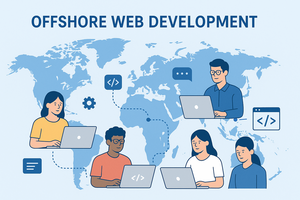Offshore Web Development: A Complete Guide for Businesses in 2025

Learn everything about offshore web development in 2025: costs, benefits, risks, and success strategies for businesses. Discover how to choose the right partner.
Introduction
The year 2025 marks a turning point for global businesses, where digital transformation isn’t an option but a necessity. Companies of all sizes are racing to build strong online presences, launch apps, and upgrade digital infrastructures. But building these solutions in-house often costs a fortune, especially in the U.S. and Western Europe. That’s where offshore web development comes into play.
Offshore outsourcing is more than just a cost-saving measure—it’s a strategy that provides access to a wider talent pool, accelerates project timelines, and offers scalability. For businesses exploring this option for the first time, the process may feel overwhelming—just like a first-time driver searching for car insurance. Should you choose a low cost car insurance for first time drivers, or is it better to pay more for reliability? Similarly, offshore outsourcing involves balancing cost, quality, and trust.
In this guide, we’ll walk you through everything you need to know about offshore web development in 2025.
What is Offshore Web Development?
Offshore web development is the process of outsourcing website or software creation to a team based in another country. Businesses often turn to regions like India, Eastern Europe, the Philippines, or Latin America, where labor costs are lower, yet technical expertise is abundant.
Key services typically outsourced include:
-
Web design and development
-
Mobile app development
-
E-commerce platforms
-
UI/UX design
-
Cloud-based solutions
-
Ongoing support & maintenance
Much like the best car insurance for first time drivers, offshore development must offer affordability, coverage (services), and peace of mind.
Why Offshore Development is Popular in 2025
The offshore outsourcing model is booming in 2025 due to:
-
Global talent shortages in the tech industry.
-
Remote work normalization, making cross-border collaboration seamless.
-
Rising local costs in developed nations, forcing businesses to look abroad.
-
Increased expertise of offshore firms in AI, blockchain, cloud, and cybersecurity.
Just as the cost of car insurance for first time drivers has risen over time, so have local development costs, making offshore partnerships more attractive than ever.
Benefits of Offshore Web Development for Businesses
Businesses choose offshore outsourcing for several reasons:
-
Cost Efficiency – Developers in Asia or Eastern Europe often charge 60–70% less than U.S. developers.
-
Access to Global Skills – Offshore firms often specialize in cutting-edge technologies.
-
24/7 Productivity – Time zone differences mean work continues even after your local office closes.
-
Flexibility and Scalability – Scale teams up or down depending on your project.
-
Focus on Core Activities – Delegate technical aspects while focusing on business growth.
It’s similar to choosing a good car insurance for first time drivers—affordability must be paired with reliability.
Challenges of Offshore Development
While offshore development offers many benefits, businesses must be aware of potential issues:
-
Communication Barriers due to different languages or time zones.
-
Quality Control if you don’t properly vet your outsourcing partner.
-
Security Concerns when sharing sensitive information across borders.
-
Cultural Differences that can affect teamwork and expectations.
This is much like the problem faced by drivers trying to find cheap car insurance for first time drivers over 25—you want affordability, but you cannot compromise on coverage.
Offshore vs. Onshore vs. Nearshore Outsourcing
Businesses have three main choices:
-
Onshore outsourcing: Same country; best communication but highest costs.
-
Nearshore outsourcing: Neighboring country; moderate costs, cultural alignment.
-
Offshore outsourcing: Distant country; lowest costs, diverse skill sets.
It mirrors the decision of what is the best car insurance for first time drivers—there’s no one-size-fits-all. You must weigh pros and cons.
Top Offshore Outsourcing Destinations in 2025
Some of the most popular regions for outsourcing in 2025 include:
-
India: Affordable, massive talent pool, expertise in full-stack and mobile development.
-
Ukraine & Poland: Strong technical expertise, ideal for fintech and enterprise projects.
-
Philippines: English-speaking professionals, excellent in customer-facing roles.
-
Vietnam: Growing IT hub with competitive pricing.
-
Latin America: Convenient time zone for U.S. businesses.
Just as with low cost car insurance for first time drivers, you need to compare options before choosing.
Offshore Web Development Costs in 2025
The cost depends on the developer’s location and skill level. Here’s an estimate:
-
India & Southeast Asia: $20–40/hour
-
Eastern Europe: $35–70/hour
-
Latin America: $30–60/hour
-
U.S./Western Europe: $100–150+/hour
This is similar to asking, how much is car insurance for first time drivers? The answer varies by country, provider, and risk factors.
Types of Offshore Development Services
Offshore providers offer a wide array of services:
-
Front-end Development – React, Angular, Vue.js.
-
Back-end Development – PHP, Python, Node.js, Ruby.
-
Mobile App Development – iOS, Android, cross-platform.
-
E-commerce Solutions – Shopify, WooCommerce, Magento.
-
UI/UX Design – Wireframes, prototypes, user testing.
-
Cloud & DevOps – AWS, Azure, GCP solutions.
-
Maintenance – Continuous upgrades and bug fixing.
Think of it like a best car insurance for first time drivers package—you want full coverage.
How to Choose the Right Offshore Partner
To ensure success, follow these steps:
-
Research and shortlist companies with strong portfolios.
-
Check client testimonials and case studies.
-
Test communication skills before committing.
-
Run a pilot project to gauge quality.
-
Sign legal agreements to protect intellectual property.
This is similar to picking a good car insurance for first time drivers—do your research, check reviews, and test the waters before committing.
Tools to Manage Offshore Teams
Remote teams require robust tools for communication and productivity:
-
Communication: Slack, Zoom, Microsoft Teams.
-
Project Management: Jira, Trello, Asana.
-
Code Collaboration: GitHub, Bitbucket, GitLab.
-
Time Tracking: Hubstaff, Time Doctor.
-
Cloud Sharing: Google Workspace, Dropbox.
These tools keep projects running smoothly, like how a reliable insurance plan keeps drivers stress-free.
Security Considerations in Offshore Development
Businesses must ensure security while outsourcing offshore:
-
Use NDAs and legal contracts.
-
Ensure compliance with GDPR, HIPAA, PCI DSS.
-
Set up encrypted data transfer.
-
Regularly audit offshore teams.
Just like drivers protect themselves with car insurance for first time drivers, businesses must secure data with strong protocols.
Offshore Development for Startups
Startups gain the most from offshore outsourcing:
-
Lower upfront investment.
-
Faster time-to-market.
-
Access to world-class talent.
It’s like cheap car insurance for first time drivers over 25—you get maximum benefits at reduced costs.
Offshore Development for Enterprises
Large corporations benefit through:
-
Scaling development quickly.
-
Specialized talent pools for AI, fintech, or blockchain.
-
Cost reduction for large-scale operations.
It’s similar to selecting what is the best car insurance for first time drivers—big decisions need reliability and strong coverage.
Case Studies: Offshore Outsourcing Success
-
WhatsApp: Early development outsourced to Eastern Europe.
-
Slack: Used offshore developers before scaling.
-
Alibaba: Relied on offshore teams in early stages.
These examples prove offshore outsourcing builds billion-dollar companies.
The Future of Offshore Web Development in 2025 and Beyond
Future trends include:
-
Growth of AI-powered development.
-
More hybrid teams combining onshore + offshore.
-
Emphasis on cybersecurity compliance.
-
Increased use of cloud-native technologies.
Just as car insurance for first time drivers evolves with new policies and technology, offshore outsourcing continues to adapt.
Conclusion
Offshore web development in 2025 is more than a cost-saving option—it’s a strategic advantage. With the right partner, businesses can gain scalability, innovation, and affordability. Just as first-time drivers carefully choose insurance providers, businesses must carefully choose offshore teams.
Whether you are a startup seeking rapid growth or a global enterprise expanding digital services, offshore outsourcing can help you thrive. The key lies in research, planning, and long-term partnerships.
